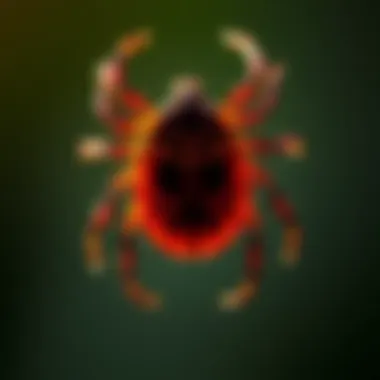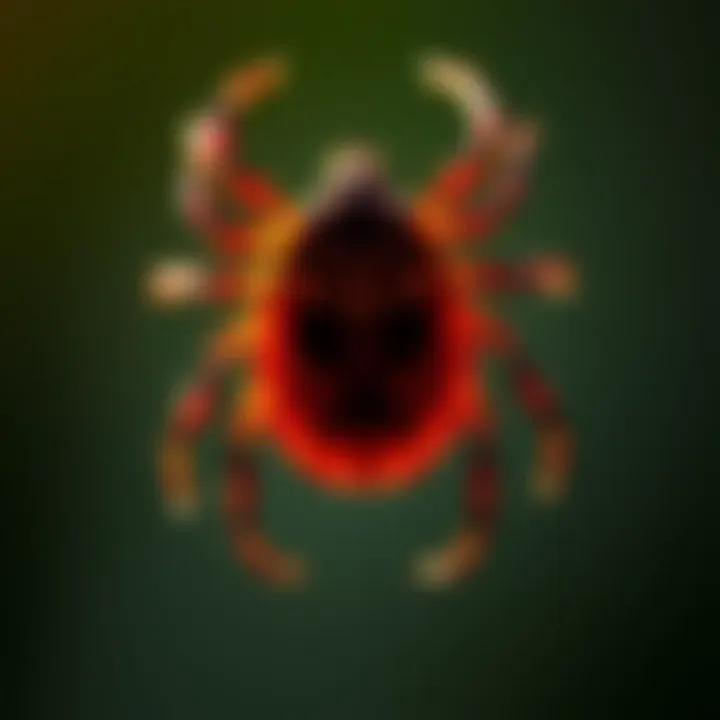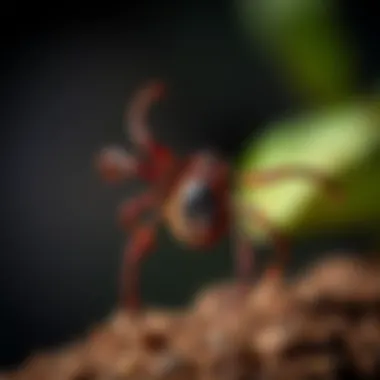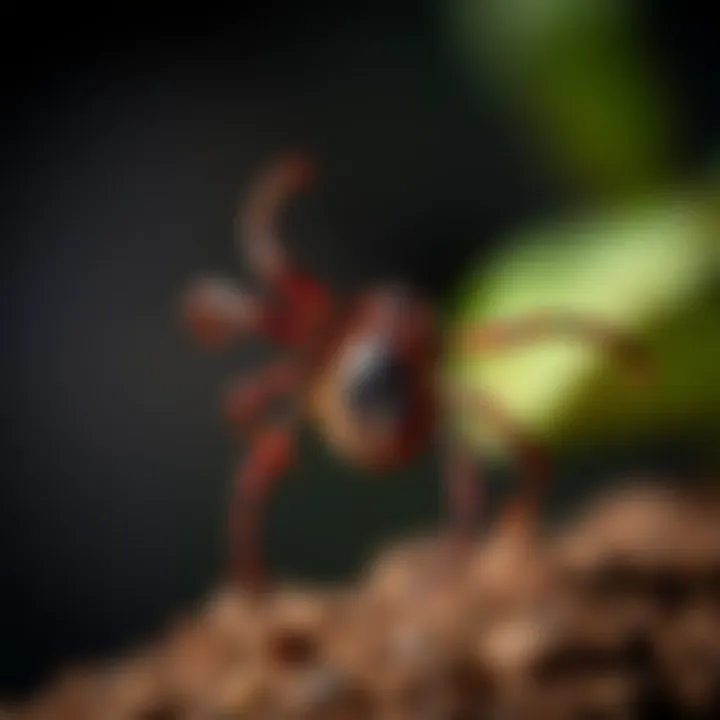Talstar Tick Spray: Effective Management of Ticks


Intro
In the realm of pest control, particularly in the fight against ticks, Talstar tick spray stands as a notable contender. With the increasing awareness of ticks and the diseases they carry, understanding effective management tools is paramount for homeowners and garden enthusiasts alike. Ticks are not just a seasonal nuisance; they pose significant health risks to humans and pets. Therefore, addressing their populations with informed strategies can greatly enhance safety and enjoyment in outdoor spaces.
As we delve into the efficacy of Talstar, we’ll explore its active ingredients, application methods, and pertinent safety guidelines. The aim is to provide homeowners and pest management professionals with a comprehensive guide, facilitating informed decisions on tick management without compromising environmental responsibilities. Through a detailed examination, this article intends to equip readers with vital knowledge on both the benefits and considerations of using Talstar in their pest control arsenal.
Prelude to Tick Management
Ticks are more than just a nuisance; they’re tiny powerhouses of potential health risks. The management of tick populations has emerged as a pressing issue for homeowners, gardeners, and outdoor enthusiasts alike. Proper tick control not only safeguards your family and pets from venomous bites but also mitigates the broader risk of tick-borne diseases. Understanding the importance of effective tick management is the first step in protecting your home and maintaining a healthy environment.
The Significance of Tick Control
Tick control is crucial for various reasons. Firstly, ticks are vectors for several diseases, including Lyme disease, which can have serious long-term health implications. Without proper management, these dreaded arachnids can establish themselves in backyards and parks, putting children and pets at risk. A simple walk outside may expose one to these pests lurking in the grass.
Moreover, effective tick control contributes to community health. As residents take action in their own yards, the collective effect can dramatically lower tick populations in the area. This action helps in creating safer outdoor spaces and provides peace of mind.
The economic side cannot be neglected either; managing tick populations can ultimately save on costly vet bills and medical expenses. In addition, tick control fosters a more enjoyable outdoor experience, allowing families and friends to indulge in outdoor activities without the constant worry of these pests.
Overview of Talstar Tick Spray
Talstar tick spray is a prominent player in tick management, regarded by many for its effectiveness. The formulation is based on active ingredients that target specific tick behaviors and life cycles. This spray not only acts as a deterrent but also aids in reducing existing populations. Often praised for its versatility, Talstar can be employed in various environments—be it gardens, backyards, or heavily wooded areas where ticks tend to thrive.
What sets Talstar apart is its ease of application, which is appealing for homeowners who may not have extensive pest management experience. It offers a user-friendly approach, allowing individuals to take immediate action against ticks in their surroundings. Furthermore, its residual effects provide a long-lasting solution, ensuring that the battle against ticks continues well after the initial application.
Understanding the mechanics behind Talstar tick spray, including its active ingredients and targeted approach to application, will set the stage for effective tick management. With the right knowledge and tools, individuals can protect their homes and loved ones from this all-too-common pest. For a comprehensive understanding of the full range of benefits and considerations of using Talstar, continuing to explore the details in the following sections is essential.
Understanding Ticks
Understanding ticks is crucial, especially when considering the impact they have on human health, pets, and wildlife. In this section, we’ll delve into the various types of ticks and the diseases they can transmit. Recognizing these pests not only aids in effective management strategies but also heightens awareness of their potential dangers.
Types of Ticks
Ticks are often categorized based on their species, and each type has unique behaviors that can influence how they are managed.
Deer Ticks
Deer ticks, also known as black-legged ticks, primarily inhabit wooded areas where they can latch onto animals. A defining characteristic of deer ticks is their small size in the nymph stage, which makes them harder to spot. This is beneficial for them as they can attach to unsuspecting hosts.
They are particularly notorious for spreading Lyme disease, a serious condition that can lead to long-term health complications if not treated adequately. Their stealthy nature and connection to Lyme disease make deer ticks a focal point in discussions related to tick management. Many tend to underestimate their presence, making them a silent yet impactful player in tick populations.
Wood Ticks
Wood ticks commonly thrive in grassy and wooded environments, predominantly in the eastern United States. They are larger than deer ticks, with identifiable white markings on their backs, which can help in identifying them.
The primary concern with wood ticks is their role in transmitting Rocky Mountain spotted fever. Despite being perceived as less of a threat than deer ticks in some regions, wood ticks can still pose significant health risks. Their higher visibility can sometimes give a false sense of security to those in infested areas.
Brown Dog Ticks
The brown dog tick is somewhat unique as it primarily infests dogs and can be found in urban environments. A key feature of this tick is its capacity to reproduce indoors, exacerbating infestations. Brown dog ticks are less frequently associated with severe human diseases but can still transmit diseases to pets and may cause discomfort.
Understanding the behavior of brown dog ticks is essential for pet owners, particularly those who live in regions with stray animal populations. While they may not be as dangerous as other ticks, they can create various challenges, making their management a relevant concern for dog owners.
Tick-Borne Diseases
Ticks are infamous carriers of various diseases that can have severe implications. Understanding these diseases is essential to gauge the importance of aggressive tick management strategies.
Lyme Disease
Lyme disease emerges as one of the most recognized tick-borne illnesses. It stems primarily from deer ticks, and its symptoms often include fever, headache, fatigue, and a characteristic skin rash. If left untreated, Lyme can lead to more serious health issues, affecting the heart, joints, and nervous system. The overlap of deer ticks with popular outdoor activities is a concern, making public awareness particularly important.
Rocky Mountain Spotted Fever
This disease is carried mainly by wood ticks and presents itself with fever, rash, and can be fatal if not treated swiftly. Its connection to wood ticks makes it a point of interest, with specific symptoms that can sometimes mimic other diseases, making diagnosis tricky. This factor underlines the necessity for education and vigilance in areas where wood ticks are prevalent.


Anaplasmosis
Anaplasmosis, though less commonly discussed, is another tick-borne disease transmitted by deer ticks. Symptoms include fever, headache, chills, and muscle aches. It can also lead to severe health complications if not treated early. With such implications, understanding tick behavior and habitats is vital to implementing effective management plans.
By grasping the various types of ticks, their behaviors, and the diseases they harbor, stakeholders can make informed decisions about prevention and treatment strategies, ultimately bolstering efforts to protect themselves and their communities.
Active Ingredients in Talstar
Understanding the active ingredients in Talstar is not just a curiosity; it's a fundamental step for anyone serious about effective tick management. Having a grasp on what goes into this product can bridge the gap between mere use and informed application. This knowledge can also reassure homeowners about safety protocols, ensuring they make smart choices for their environment and health.
Bifenthrin: The Main Component
Bifenthrin stands out as the primary active ingredient in Talstar, and for good reason. This synthetic pyrethroid mimics the natural insecticides produced by chrysanthemum flowers, providing a potent weapon against ticks. Its effectiveness stems from the way it interferes with the tick's nervous system, causing a swift and lethal response. This active component works well in various conditions, making it a reliable choice for all around tick control.
When choosing a tick spray, the concentration of bifenthrin should be taken into account. A higher concentration might yield faster results, but it is essential to balance efficacy with safety. Moreover, bifenthrin is favored not only for its effectiveness, but also for its relatively low toxicity to humans and pets, provided it is used as directed.
Mechanism of Action
Neurotoxicity to Ticks
The neurotoxic effect that bifenthrin has on ticks is crucial for understanding how Talstar achieves its effectiveness. It disrupts the normal functioning of the tick's nervous system, leading to paralysis and eventual death. This mechanism acts quickly, which is vital when dealing with a potentially dangerous population of ticks, as they can transmit diseases like Lyme and Rocky Mountain spotted fever.
A key characteristic of this neurotoxic action is its specificity. Unlike broad-spectrum insecticides that may indiscriminately affect many species, the targeted approach of bifenthrin minimizes collateral damage to beneficial insects. This specificity makes it a favorite for environmentally-conscious homeowners who wish to manage pests effectively without wreaking havoc on local ecosystems.
Nonetheless, it's worth noting that even targeted neurotoxicity can lead to residues that may affect non-target species. Therefore, following application guidelines can help mitigate these concerns.
Residual Activity
Another significant property of bifenthrin is its residual activity. This feature allows the active ingredient to remain effective on treated surfaces for an extended period, providing ongoing protection against ticks. When applied correctly, Talstar can create a barrier that deters new ticks from entering treated areas.
The ability to maintain efficacy over time speaks to the unique formulation of Talstar. Users value this aspect, as it translates to fewer reapplications and ultimately less work in the long run. However, it does come with a responsibility. Proper timing and environmental conditions must be considered to maximize this advantage.
While the long-lasting effects are appealing, careful monitoring is necessary to observe how the product interacts with various weather conditions and types of surfaces. Overapplication or improper timing could lead to an unintentional buildup of chemicals that might negatively affect the local flora and fauna.
In summary, the active ingredients within Talstar, especially bifenthrin, not only contribute to its effectiveness but also prompt important considerations for responsible usage. Understanding these elements makes homeowners, landscapers, and pest control professionals better equipped to manage tick populations while safeguarding the environment.
Application of Talstar Tick Spray
The application of Talstar Tick Spray is a cornerstone of effective tick management strategies. This section delves into the essential elements that surround its use. Applying any insecticide without proper understanding could lead to ineffective results and potential safety hazards. Here, we explore what needs to be considered before spraying and how to best utilize Talstar for optimal effectiveness.
Pre-Application Considerations
Identifying Tick Hotspots
Identifying tick hotspots can dramatically enhance the effectiveness of Talstar. Knowing where ticks are most prevalent allows homeowners to focus their efforts where they are needed most. These hotspots often include leaf litter under trees, tall grass, and areas close to wildlife trails.
One key characteristic of recognizing these hotspots is understanding tick habitats. Ticks thrive in moist, shaded environments where they can easily latch onto hosts. This makes identifying hotspots not only a smart but also a necessary choice when considering Talstar's application.
The unique feature of this process is the ability to create targeted treatment areas rather than a broad application, saving both time and product. However, a disadvantage could be the time it takes to thoroughly investigate your property. Still, the effort pays off as it leads to more efficient use of Talstar, ensuring that you're not wasting resources on areas that aren't infested.
Protective Gear
Before applying Talstar, wearing the right protective gear is non-negotiable. This is critical not just for safety but also for maximizing the effectiveness of the application. Protective gear includes long sleeves, gloves, and possibly a face mask, depending on sensitivity.
The significant aspect of wearing protective gear is it minimizes exposure risk to harmful chemicals. This feature is particularly beneficial for those who may have sensitivities or allergies. Having a full suit may add some bulk, which can seem cumbersome, yet it is a small sacrifice for personal safety. Lesser-known benefits included the peace of mind that comes with being adequately covered.
Application Techniques
Spraying Methodology
Understanding spraying methodology directly impacts the efficacy of Talstar. It involves not just how much to spray but also the angle, distance, and technique used during application. A fan spray is often more effective than a point spray as it covers more area and applies a more uniform coat of the substance.
A key characteristic of this methodology is the focus on even distribution. This way, Talstar can permeate various habitats and surfaces, reaching ticks effectively. The distinct advantage here is that an even application decreases the likelihood of missed spots, which is crucial in tick eradication. However, improper angles or distances might reduce coverage, allowing ticks to escape unscathed.


Timing of Treatment
Timing can make or break your tick management strategy. Talstar is best applied during peak seasons for ticks, which are generally in the spring and fall. Knowing when to treat your yard ensures that the application is most effective, while improper timing could leave your property vulnerable to tick activity.
The fundamental characteristic here lies in understanding tick life cycles. Treating at the right moment can prevent ticks from maturing to a stage where they can breed, effectively curbing infestation levels. This targeted timing provides a marked advantage, albeit the challenge lies in ensuring that treatment aligns perfectly with tick activity periods. If missed, it could lead to further complications down the line.
Proper application of Talstar Tick Spray, including the timing and methodology, can significantly reduce the risk of ticks and the diseases they carry.
In summary, the application of Talstar Tick Spray involves several critical considerations, from understanding where to spray to when to do it. By paying attention to these details, homeowners can take effective steps towards managing tick populations, ensuring a safer environment for themselves and their families.
Safety and Environmental Considerations
Understanding safety and environmental considerations surrounding the use of Talstar Tick Spray is critical for both effective tick management and ecological health. Given the rise in awareness about pesticide effects, examining these aspects ensures that homeowners can utilize Talstar while safeguarding their family, pets, and the surrounding ecosystem. Keeping the balance between managing tick populations and protecting beneficial organisms is not merely advisable but essential.
Human Health Safety
Toxicity Levels
When discussing toxicity levels associated with Talstar, it's crucial to highlight its relatively low risk to human health when used as directed. Talstar contains bifenthrin, which is categorized as a Class III pesticide, indicating it has low acute toxicity for humans. This classification makes it a more attractive option for homeowners concerned about the effects of chemical exposures. It is important to note that while it's usually safe, it can still pose risks if proper safety guidelines aren't followed. A key characteristic of bifenthrin is its neurotoxic effect specifically on arthropods, which means that unlike some stronger chemicals, it doesn't compromise human nerve functions. This is what makes Talstar a favored choice for pest management.
However, it’s vital to address the potential for environmental persistence and the implications it has. Bifenthrin can remain in soil and water for a considerable time, potentially affecting surrounding areas. Thus, users must consider timing and conditions when applying.
First Aid Measures
In the unlikely event of exposure, first aid measures are particularly significant to ensure safety when using Talstar Tick Spray. The manufacturer's guidelines offer insights for first aid in cases of inhalation or skin contact. A highlighted feature of these measures includes immediate washing with soap and water if the spray contacts the skin. This quick response can significantly mitigate adverse effects.
Homeowners must recognize that the advice given is designed to handle situations where precautionary measures may have faltered, underscoring Talstar's overall safety profile. It is reassuringly straightforward: wash off, seek fresh air, and consult a medical professional if symptoms persist. This clarity around first aid is an advantage of the product, serving as a safety net for consumers in the face of common missteps during application.
Impact on Non-Target Species
Pollinators
The impact of Talstar on non-target species, particularly pollinators like bees, is a significant concern for anyone engaged in gardening or lawn care. Bees and other beneficial pollinators are crucial to the ecosystem and essential for food production. Talstar, while effective against ticks, has been shown to cause harm to pollinator populations if applied incorrectly or in times of active bee activity. Homeowners should opt for targeted application methods and select timings that minimize contact with these vital insects. However, it’s essential to realize that using Talstar responsibly can mean that far less frequent and less concentrated applications may mitigate negative effects while still managing tick populations effectively.
Beneficial Insects
Similarly, beneficial insects, such as ladybugs and lacewings, play a crucial role in controlling harmful pest populations. The challenge with a product like Talstar is balancing efficacy in tick management with safeguarding these insects. Important to note is that while Talstar is less toxic to many beneficial insects than some other pesticides, indiscriminate application can still lead to unintended consequences. Understanding the life cycle and behavior of these insects can guide when and where Talstar is used, often allowing homeowners to protect the broader ecological fabric of their gardens. Thus, engaging in thoughtful timing and targeting during treatment can safeguard beneficial insect populations, advocating for a healthier ecosystem.
By considering these safety and environmental elements, readers can develop a more nuanced understanding of Talstar Tick Spray and its place within integrated pest management. Armed with this knowledge, homeowners can make informed decisions that ensure effective tick control without compromising their environments.
Integrated Pest Management (IPM)
Integrated Pest Management, or IPM, serves as a comprehensive strategy that seeks to manage pest populations effectively while minimizing risks to human health and the environment. The significance of this approach cannot be overstated, particularly in the context of tick management. Ticks, known for transmitting diseases, require a nuanced solution rather than a one-size-fits-all remedy. The core principles of IPM emphasize the use of multiple tactics that are tailored and adaptive to local conditions. This allows for effective control with minimized reliance on pesticides like Talstar Tick Spray, protecting both people and wildlife.
Role of Talstar in IPM
Talstar Tick Spray is a valuable asset within an IPM framework. Its inclusion allows for targeted pest control efforts, ensuring that the application is both effective and responsible. By employing a product like Talstar, users can strategically reduce tick populations while also taking into account the broader ecosystem. This means the use of Talstar is not merely about eradication; rather, it is intended to harmonize with other pest control methods.
The efficacy of Talstar is further enhanced when integrated with monitoring systems to assess tick activity, allowing for timely applications. This proactive approach means that homeowners can work to prevent infestations rather than simply reactive measures after ticks become a problem.
Complementary Controls
Cultural Practices
Cultural practices refer to the various techniques that can deter pest infestations, going beyond mere pesticide applications. This method might involve altering environmental conditions that are conducive to tick survival. For example, managing landscape vegetation by keeping grass short and removing leaf litter can create an environment where ticks are less likely to thrive.
The key characteristic of these practices is their dependency on management of the physical landscape rather than using chemical controls. This makes cultural practices a beneficial choice for homeowners. They present a low-cost, sustainable way to reduce tick populations over the long term.
However, the unique feature of cultural practices lies in their slow and steady approach. Unlike immediate results from a spray, these methods may take time to show significant impacts, requiring patience and consistency from the users. As beneficial as they can be, they are often supplemented by other control methods for best results.
Biological Control
Biological control employs natural predators or parasites to keep tick populations in check. This method can be a game changer, as it reduces reliance on chemical pesticides and incorporates ecological principles. For instance, introducing certain bird species that feed on ticks can serve as a natural deterrent. This approach can enrich the ecosystem while addressing the tick issue effectively.


The essential characteristic that makes biological control appealing is its sustainability. Biocontrol methods generally aim for a balance, allowing for co-existence of natural systems without heavy disruption. Homeowners see this as a beneficial aspect because it can lead to long-term solutions without the adverse effects typically seen with chemical applications.
Despite its advantages, biological control does require careful planning and understanding of local ecosystems. This means that while it’s a smart choice, it can sometimes necessitate expert advice to ensure that the predatory species introduced are compatible and effective.
"IPM isn’t about finding a quick fix. It offers a holistic solution that respects our environment and promotes sustainable practices."
Cost-Effectiveness of Talstar Tick Spray
Navigating the realm of pest control can often feel like walking through a minefield, especially when you consider the expenses involved. Thus, understanding the cost-effectiveness of Talstar tick spray is essential for any homeowner seeking a viable solution in the ongoing battle against ticks. This consideration isn’t merely about the price tag but rather about the value it brings to your pest management strategy. When evaluating any product like Talstar, a few critical aspects come into play: overall costs, benefits, and long-term savings.
Cost Analysis
Comparative Pricing
When discussing comparative pricing in relation to Talstar tick spray, it’s important to approach it from two angles: the competitive landscape and its unique value proposition. Compared to other products, Talstar often falls within a middle range of pricing. However, it stands out due to its concentration and effectiveness, offering a compelling return on investment.
One unique feature of comparative pricing for Talstar is its dual aspect of affordability and efficacy. Users can find cheaper options on the market, but they may end up requiring additional applications or being less effective overall. This can often lead to higher cumulative costs over time. Choosing Talstar can be viewed as a more economical option in the long run, as it usually provides more bang for your buck with its lasting effects and fewer necessary reapplications.
One must consider how this pricing strategy resonates with the target audience. For households where ticks are a recurring issue, the investment is justified by reduced health risks and the added peace of mind it delivers.
Long-Term Benefits
Examining the long-term benefits of using Talstar tick spray reveals how critical it is to think beyond the initial purchase price. Talstar's formulation not only addresses current tick populations but also reduces future infestations, making it a strategic buy rather than just a momentary expense. One significant aspect of long-term benefits is its residual effects, which can continue to protect spaces for extended periods.
The unique feature here is Talstar’s lasting power against various tick species. Homeowners may find they spend less on additional pest control measures thanks to Talstar’s effective duration. Unlike many other tick sprays that require frequent applications, this longevity results in more money saved over time.
"The secret to fighting ticks isn’t just in the spraying; it’s in the strategy that aligns with protecting your home for the long haul."
For further insights into pest management practices, you may visit the following resources:
- Centers for Disease Control and Prevention on Tick Prevention
- EPA on Pesticides and Your Health
- University of Florida Institute of Food and Agricultural Sciences: Tick Management
Common Myths and Misconceptions
Understanding the common myths and misconceptions surrounding tick management is crucial for effective prevention and control strategies. This section aims to clarify some of the prevalent inaccuracies circulating among homeowners and those involved in pest management. Dispelling these myths can enable individuals to make more informed decisions about using chemical pesticides like Talstar tick spray while also improving their overall knowledge of tick behavior.
Myths about Chemical Pesticides
There are numerous misunderstandings regarding the use of chemical pesticides, particularly Talstar tick spray. One of the most significant myths is that all chemical pesticides pose an equal threat to human health and the environment. This is simply not true. Talstar, for instance, is designed with specific formulations that focus on targeting pests like ticks without broadly affecting non-target species. Misconceptions about toxicity often stem from anecdotal evidence or exaggerated claims.
"Chemical pesticides are always harmful to people and pets."
Though safety regulations and labeling practices ensure that these products are used responsibly, many people are unaware that pesticide applications can be made safely with proper care and precautions.
Other common myths include:
- Chemical pesticides only harm pests. This overlooks the potential impact on beneficial organisms if not used correctly.
- The more pesticide used, the better the results. Overapplication can lead not only to ineffectiveness but also increase the risk of environmental harm.
When using Talstar tick spray, it is essential to read labels carefully and adhere to the guidelines provided. This way, users can maximize efficacy while minimizing risks to themselves, their loved ones, and the environment.
Misconceptions about Tick Behavior
Ticks are often maligned creatures, surrounded by misunderstandings that cloud the knowledge of their behavior. One pervasive misconception is that ticks drop from trees onto unsuspecting victims. In reality, ticks typically wait on grasses or shrubs, using a strategy called questing—where they extend their legs to latch onto a passing host. Knowing where ticks are likely to be can significantly reduce the chances of an encounter.
Another common belief is that ticks are only active during the warmer months. While many people associate ticks with summer, it is essential to note that some species can be active well into the fall and even winter, particularly in warmer regions. This highlights the need for ongoing tick control measures, regardless of the season.
Moreover, some individuals think that only heavily wooded areas are home to ticks. Although wooded areas are indeed habitats for these parasites, they can also be found in grassy areas and even gardens, making regular monitoring and preventive treatment crucial.
By understanding tick behavior and the effective application of products like Talstar, homeowners can take necessary steps to protect their living spaces and enjoy peace of mind. Properly dispelling myths and misconceptions about both chemical pesticides and tick behavior will empower readers to implement better tick management strategies.
Epilogue and Recommendations
Tick management can often feel like a never-ending battle for homeowners and gardeners alike. The sheer anxiety that comes with the threat of ticks, bearing the potential to transmit serious diseases, emphasizes the need for effective solutions. In this article, we have highlighted Talstar Tick Spray as a formidable ally in the quest to control tick populations.
Summary of Key Points
- Efficacy of Bifenthrin: The active ingredient, bifenthrin, is a powerful insecticide that targets the nervous system of ticks, leading to rapid knockdown and mortality. Its residual effect also ensures prolonged protection of treated areas.
- Application Methods: Proper application techniques are crucial. Identifying hotspots and using protective gear during spraying helps maximize effectiveness while ensuring safety for humans and pets.
- Safety Protocols: Attention to human health safety and environmental impacts cannot be overstated. Understanding toxicity levels and knowing first aid measures are essential components for responsible usage.
- Integrated Pest Management: Talstar should not be viewed as a standalone solution but as a part of an Integrated Pest Management strategy. This comprehensive approach, including cultural practices and biological controls, enhances overall effectiveness while minimizing adverse impacts.
Final Thoughts on Talstar Usage
Ultimately, the choice to utilize Talstar Tick Spray should be approached thoughtfully. Here are some considerations:
- Effectiveness: Many homeowners have reported significant reductions in tick problems after using Talstar, suggesting that it can genuinely be effective as part of a proactive tick management strategy.
- Environmental Responsibility: While Talstar is highly effective, it is essential to balance its usage with environmental considerations. Taking care to protect non-target species, such as beneficial insects and pollinators, is vital to maintaining ecological health.
- Educate Yourself: Continually educating oneself about the ways ticks behave, their habitats, and how to manage them can enhance one’s effectiveness. Utilizing resources from reputable sites such as Wikipedia and EPA can provide valuable insights.



